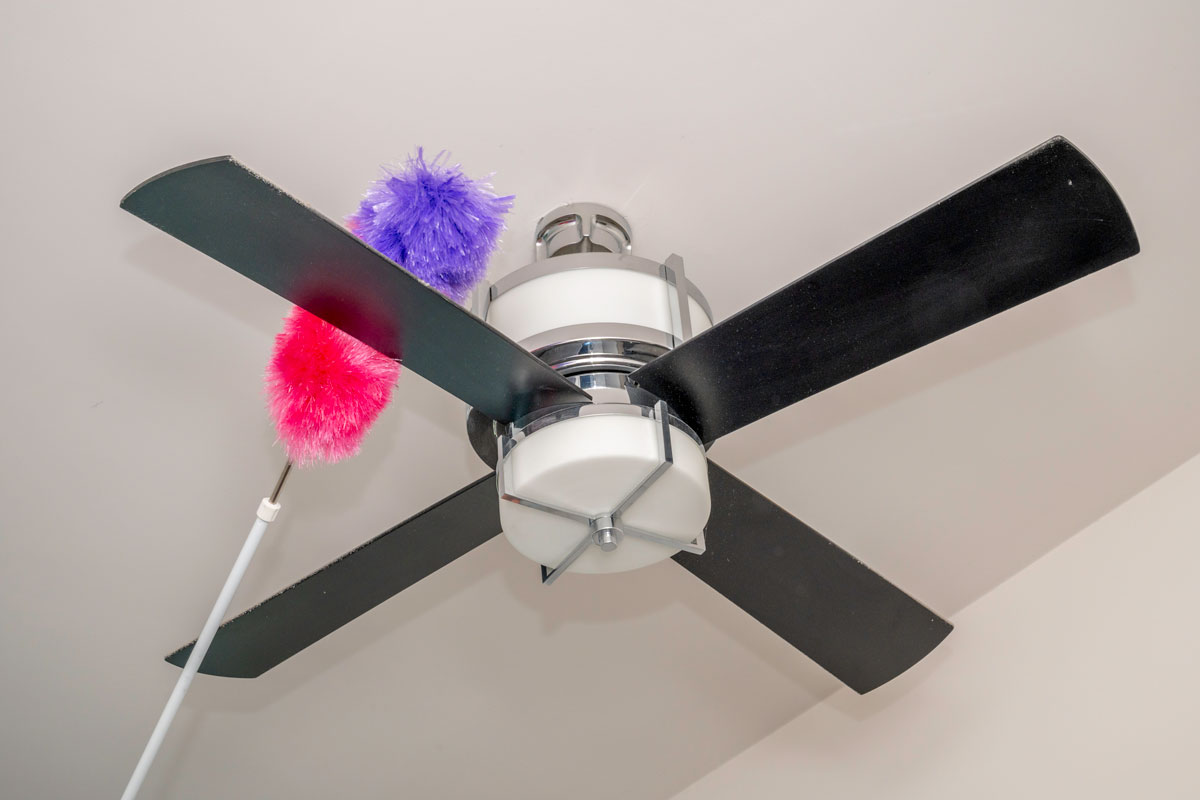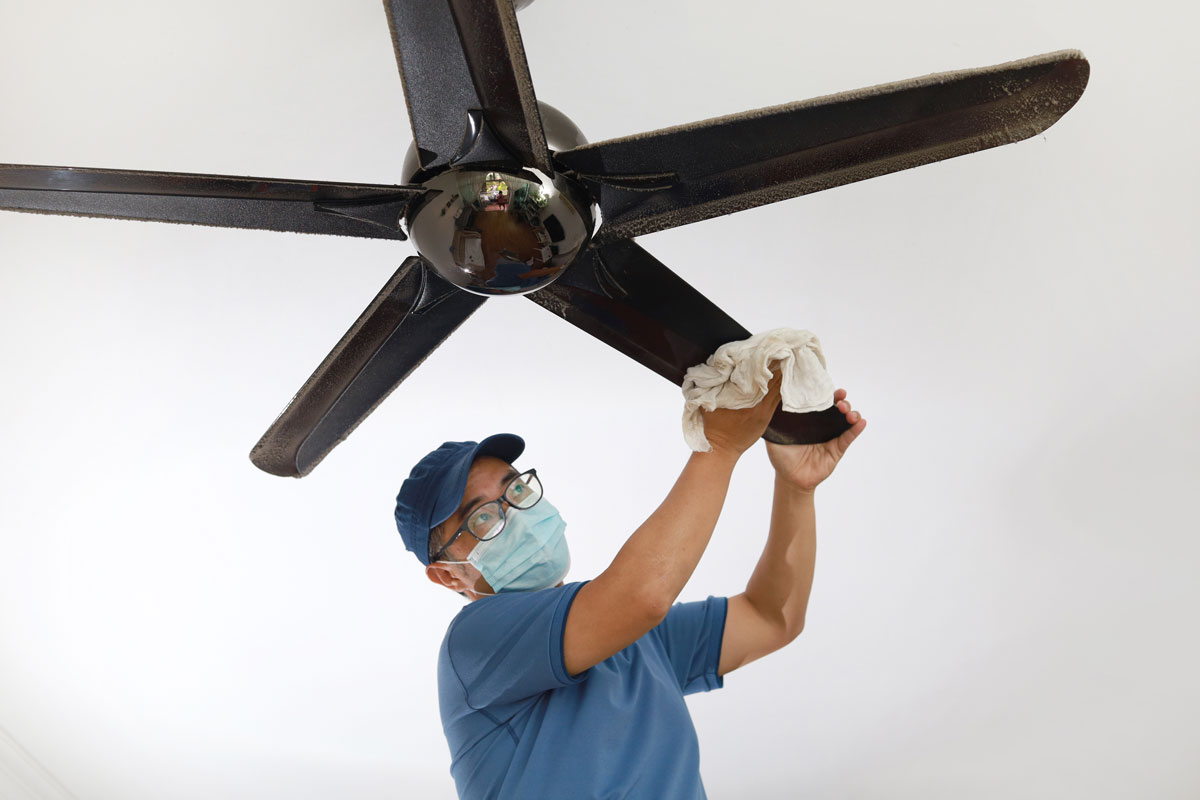A retractable ceiling fan is a unique home accent that adds style and is quite functional. Since it offers the house a beautiful appearance, it must be carefully maintained with proper cleaning. If you're worried about how to properly clean the blades of your ceiling fan, worry no more! We scoured the net for the best cleaning practices, and here's what we found.
The proper and easiest way of cleaning your retractable ceiling fan blade is by using the pillowcase hack which entails the following simple steps:
- Prepare the materials.
- Switch off the fan.
- Climb through a ladder.
- Stretch out the blades.
- Wipe with a pillowcase.
- Wipe again with a clean cloth.
This is an effective way to clean your retractable ceiling fan blades. Continue reading to learn more about the detailed steps to clean your retractable ceiling fan.
![Old Ceiling fan and cobwebs Old Electric Fan, How To Clean Blades On A Retractable Ceiling Fan [Step By Step Guide]](https://hvacseer.com/wp-content/uploads/2022/09/How-To-Clean-Blades-On-A-Retractable-Ceiling-Fan-Step-By-Step-Guide.jpg)
Step-By-Step Guide
A retractable ceiling fan will acquire dirt on its blades like any other fan. To thoroughly clean your fan, members of a Q & A site suggest a straightforward procedure:
1. Prepare The Materials
Here's what you'll need in cleaning the retractable ceiling fan blades:
- Pillowcase
- Soft clean cloth
- Ladder
- Spray with cleaning solution
2. Switch Off The Fan
Before you begin cleaning, make sure to turn off the ceiling fan. To be extra sure, remove the plug from the socket.
3. Climb Through A Ladder
Since you are going to clean a fan blade that is installed in the ceiling you'll be needing a ladder. Be sure to place the ladder properly to avoid an accident.
4. Stretch Out The Blades

Ask someone who can help you clean the blades to make the work easier. On both sides, pull each blade at the same time. The reason you need an extra hand on this is to avoid damaging the blades.
5. Wipe With A Pillowcase
Insert the fan blade into the pillowcase. Softly press against the blade, and then draw the pillowcase back. Repeat this on every fan blade until you are done. Using this hack will prevent dust from spreading all over the floor. This will save time and effort. Otherwise, you'll have to thoroughly clean the floor afterward.
6. Wipe Again With A Clean Cloth

After using the pillowcase, use a clean and soft cloth to wipe each blade to ensure that all dirt is removed. Spray some cleaning solution, but make sure to use a light one to avoid any discoloration of the blades.
Why Does My Ceiling Fan Collect So Much Dust?

Even if our ceiling fans are constantly moving, this won't keep off the dust from sticking to the blades. There are two main reasons for this which are airflow and fluid dynamics and static electricity.
When fan blades move through the air very quickly, static electricity occurs. To get these dust bits out of the way, they brush the air molecules. On the blade's leading edge, the dust particles frequently build an electrical charge. This is the cause of the dust accumulation and adhesion on the ceiling fan's two sides.
Airflow and fluid dynamics specifically occur if your ceiling fan blades are constructed with metal. The air directly above the blades does not move while the blades rotate continuously through the air.
In other words, dust particles can stick to ceiling fan blades and stay there for a long period while there is inactive air above them. Your ceiling fan turns quite quickly because of the characteristics of airflow and fluid dynamics. And this is one of the main causes of the dust buildup there.
How Do You Keep Dust From Accumulating On Fan Blades?
Nowadays, we can buy some products that can help make our pieces of furniture and appliances dustproof. Here are some products that can help you clean less.
Pledge Multi-Surface Dust Spray
This spray removes dust and debris from most hard surfaces gently without leaving behind streaks or residue or harming the surfaces. While leaving behind a pleasing, fresh aroma, it will highlight the inherent beauty of your surfaces.
Check out this Pledge multi-surface cleaner on Amazon.
Endust No-Wax Dust Spray
The spray is free of waxes, acetone, alcohol, vinegar, ammonia, and vinegar. Since there is no wax, there is no buildup of residue. It can pick up dust while preventing allergies, fingerprints, and smudges.
Check this Endust no-wax spray on Amazon.
DIY Dust Repelling Spray
Make your dust-repelling spray by combining liquid fabric softener in one part with four parts of water. Apply this with a clean cloth to the fan blades, then wait for it to dry.
How Often Should You Dust A Ceiling Fan?
Dust can be found anywhere in the house. It is not safe and unhealthy to inhale dirty air circulating in your house. Turn off your retractable ceiling fan and you might want to check it out. Cleaning your ceiling fan must be done every month to avoid collecting too much dust that can cause allergy issues and excess dust mites.
Additionally, it can contribute to providing the home with clean air for breathing. However, there may be an exception if you have pets in the home, which can compound the problem. In this case, clean your fan every 2 weeks. Also, if a family member has asthma or other health problems that can be triggered by too much dust, then clean up regularly.
What Happens If You Don't Clean Your Fan?
When the fan spins, dust that was launched from it mixes with the air in space, which can be harmful to your health. Dust mite allergies can be acquired if you don't clean your ceiling fan.
Dust mites are insects that live in the house and are too small to be seen by the naked eye. These varmints seem to prefer warm, muggy settings. Dust mites themselves are allergenic, meaning they can cause allergies. Common symptoms of dust mite allergies are usually sneezing, coughing, stuffy nose, itchy and watery eyes, and itchy skin, and throat.
Not cleaning your fan can also result in the poor performance of your retractable ceiling fan. Too much dust on the blades will affect the production of air. The dust can add weight to each blade and can give the motor a hard time.

It won't function properly if the motor is struggling. The blades' sluggish rotation will prevent the fan from providing the necessary cooling.
How To Clean A Ceiling Fan Motor
Cleaning the blades of your fan may not be enough, so you must include cleaning the whole ceiling fan. Here's a step-by-step guide for cleaning your fan motor:
- Use a vacuum to eliminate loose dirt from the motor's parts.
- To remove dirt buildup from the plastic components of the motor, use a scrub brush dipped in a moderate liquid detergent.
- Use a garden hose or shower head to rinse the plastic parts.
- Do not yet attach the shell as you reassemble the fan motor.
- The front bearing or bushing should be oiled. Apply the same procedure to the rear bearing or bushing.
- Reassemble the remaining parts of the electric fan after securing the motor in its housing.
- Restore the electric fan's power and switch it on to test it.
If you want to learn more about this topic, check out this post: How To Clean A Fan Motor
In Closing

Dust that circulates throughout the house may be reduced by regularly cleaning your ceiling fan. Be careful to do so safely and keep in mind the steps we have discussed in cleaning your retractable ceiling fan blades.
To save cleaning time, make sure to follow the right techniques to make your fan dustproof. Prevent damage and extend your fan's lifespan with proper maintenance.
For more cleaning tips, you might want to read through this article:


